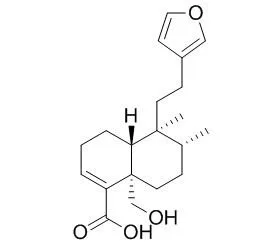| In vivo: |
| Planta Med. 2015 Sep;81(14):1240-7. | | Effect of Hautriwaic Acid Isolated from Dodonaea viscosa in a Model of Kaolin/Carrageenan-Induced Monoarthritis.[Pubmed: 26166136] | In the present work, the antiarthritic activity of Hautriwaic acid is reported.
METHODS AND RESULTS:
This ent-clerodane diterpene isolated from Dodonaea viscosa was evaluated in mice using a kaolin/carrageenan-induced monoarthritis model. The inflammation observed in the joint (knee) on days 1-8 ranged from 50-70 %. After 10 days of treatment with different doses of Hautriwaic acid (5, 10, 20 mg/kg), a decrease in knee inflammation was detected. This recovery was observed with both reference drugs, methotrexate (1 mg/kg) and diclofenac (0.75 mg/kg). In these groups of mice, the concentration of proinflammatory cytokines interleukin-1 beta, interleukin-6, and tumor necrosis factor alpha in the joint was significantly lower than that of the negative control group (animals with damage without any treatment). The negative control group presented a decrease in the concentration of interleukin-10, while the groups that received Hautriwaic acid at different dose exhibited an increase in this interleukin.
CONCLUSIONS:
This anti-inflammatory cytokine was not modified in the joint of mice with diclofenac, but in mice that received methotrexate, a significant decrease was observed. Hautriwaic acid isolated from D. viscosa diminished the joint edema induced by this mixture of polysaccharides (carrageenan), possibly by acting as immunomodulator of the inflammatory response. | | Molecules. 2012 Apr 10;17(4):4292-9. | | Anti-inflammatory activity of hautriwaic acid isolated from Dodonaea viscosa leaves.[Pubmed: 22491678] | The aim of this study was to identify an anti-inflammatory compound from D. viscosa leaves.
METHODS AND RESULTS:
The structure of this bioactive substance was elucidated by IR and NMR studies, which indicated that this natural product corresponds to Hautriwaic acid (HA). This diterpene exhibited good anti-inflammatory activity in 12-O-tetradecanoylphorbol 13-acetate (TPA) mice ear edema models by applications at doses of 0.25, 0.5 and 1.0 mg/ear (60.2, 70.2 and 87.1% inhibition, respectively); additionally Dodonaea viscosa dichloro-methane extract (DvDE) displays a 97.8% anti-inflammatory effect at 3 mg/kg. Multiple applications of DvDE at doses of 100 mg/kg on TPA mice ear edema inhibited the edema-associated inflammation by 71.8%, while HA at doses of 15 mg/kg, reduced edema to 64% and indomethacin 40%. |
|






 Cell. 2018 Jan 11;172(1-2):249-261.e12. doi: 10.1016/j.cell.2017.12.019.IF=36.216(2019)
Cell. 2018 Jan 11;172(1-2):249-261.e12. doi: 10.1016/j.cell.2017.12.019.IF=36.216(2019) Cell Metab. 2020 Mar 3;31(3):534-548.e5. doi: 10.1016/j.cmet.2020.01.002.IF=22.415(2019)
Cell Metab. 2020 Mar 3;31(3):534-548.e5. doi: 10.1016/j.cmet.2020.01.002.IF=22.415(2019) Mol Cell. 2017 Nov 16;68(4):673-685.e6. doi: 10.1016/j.molcel.2017.10.022.IF=14.548(2019)
Mol Cell. 2017 Nov 16;68(4):673-685.e6. doi: 10.1016/j.molcel.2017.10.022.IF=14.548(2019)